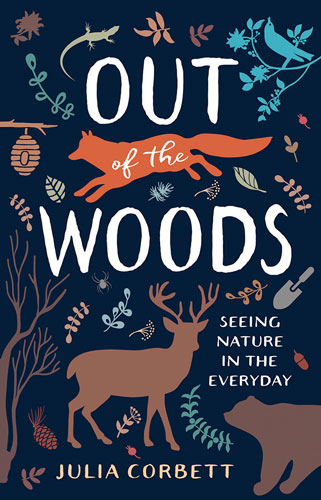Out of the Woods
Out of the Woods: Seeing Nature in the Everyday is a collection of essays by Julia Corbett that examines the false dichotomies between humans and nature, culture and wilderness. To break down these divisions, Corbett, a professor in the Department of Communication and the Environmental Humanities Graduate Program at the University of Utah, looks closely at “everyday nature”—the animals, plants, and objects in and around the cities and suburbs of America.
Out of the Woods: Seeing Nature in the Everyday is a collection of essays by Julia Corbett that examines the false dichotomies between humans and nature, culture and wilderness. To break down these divisions, Corbett, a professor in the Department of Communication and the Environmental Humanities Graduate Program at the University of Utah, looks closely at “everyday nature”—the animals, plants, and objects in and around the cities and suburbs of America.
Corbett’s essays analyze the ways that we, as twenty-first century residents of earth, tend to separate ourselves and our lives from nature. We’ve become blind, she argues, to the ways that nature exists everywhere around us—in our yards, gardens, and parks, to be sure, but also in our cellphones, carpets, and cars.
Seeing nature in everything and everyone allows Corbett to demonstrate the deep interconnectedness of life on this planet. Ultimately, her goal is to convince us that what we do, how we speak, and how we live matters to the health and future of the world we call home.
Recognizing the oneness of all things—living and manufactured, wild and tame—is a first step to solving the overwhelming environmental dangers threatening us and our world. As she says in the book’s prologue:
there is great value (indeed, urgency) in knowing and understanding living, vibrant nature and how it does what it does to produce both a towering spruce and a phone. And the best place to start truly knowing that nature is right out the front door.
These essays take a frank look at bears and insects, compost and trash, malls, and city planning. Threaded through all of them is the understanding that if we are going to untangle the mess we’re in, we have to be honest with ourselves about what we eat, consume, buy, and throw away. And we need to transform our relationship with the earth that provides the raw materials and energy that fuel our frenetic and largely unexamined lives.
One of the most moving essays in the book is the one that gives the collection its title: “Out of the Woods.” It tells the story of Corbett’s father having a stroke in woods that he loved near his house, his subsequent death, and the family’s scattering of his ashes in those same woods.
As a specialist in communication and language, Corbett analyzes the cultural meanings of the phrase “out of the woods,” showing how it reveals a deeply-rooted bias against wilderness as a dangerous, threatening place. The language we use to describe the woods, she argues, ultimately shapes how we treat the natural world:
Lifetimes of associating woods with dangerous places to escape must lead to some degree of consequence, such as “taming” woods worldwide for their treasures, and for our desire to refashion them into strip malls or palm oil plantations. But at the root, “out of the woods” speaks to the uncontrollable nature of nature, and of being mortal humans—chiefly, the terror of death.
If we can change our language and our conceptions of nature, Corbett suggests, perhaps we can learn to have a better, more sustainable relationship with the places we live, with ourselves, and with the animal and plant kin that share our home.
In another essay, “A Gardener Grows,” Corbett traces her own evolution as a gardener, from a self-described Plant Manager who attempted to create perfectly-manicured yards to a caretaker comfortable with wilder—and healthier—spaces. She describes her journey with a sense of both humor and humility, weaving in details about her various yards with ecological and environmental research.
In the end, she says that she’s gradually learned that “there is much less stress and pressure in my life if my personal identity and patriotism are not tied to how my yard looks.” Gardening, she comes to realize, “is more about observing and learning from plants, soil, and creatures of all kinds than about attempting to control and manage them.”
Humanity’s desire—and inevitable inability—to control nature is a central theme in these essays, and one of Corbett’s underlying arguments throughout is that we must learn to let go, to stop clinging, grasping, and trying to control everything and everyone around us. We need to give the earth, ourselves, and our fellow earth-inhabitants the time and space we all need to heal and flourish. We need to slow down, observe, listen, and be present.
These essays are smart, funny, and well-written. With a deceptively light touch, Corbett shows us a myriad of small ways out of our modern conundrum of consumerism and waste. Saving the earth and ourselves, she suggests, might simply be a matter of changing our minds about what it means to live with and in nature—and what it means, finally, to be natural creatures ourselves.





